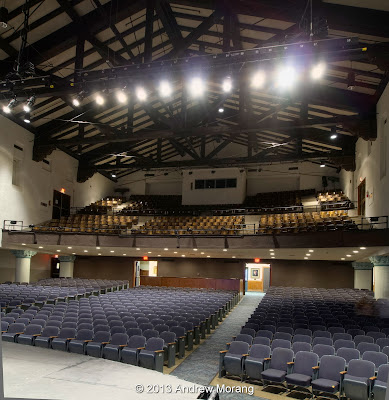 |
| Clock Auditorium ceiling with reinforcing rods. |
The roof is made of impressive timbers. Sometime in the 1960s, engineers retrofitted it to be more earthquake resistant. Steel tension rods were run across the rafters to hold the structure together during tremors.
According to the web page of the Redlands High School Drama club, the auditorium was scheduled for demolition in the early 1980s. The demolition company tested a wrecking ball against the south wall, and it bounced off, leaving only a minor dent. At that stage, the school department decided to renovate the structure. I suspect there is more to the story, but at least it was saved. Since then, the electrical system has been renovated, theater machinery replaced, and a new fire curtain installed.
Some of the hallways up in the attic are a bit spooky.
The auditorium gets regular use. This was the inaugural concert of the Redlands Community Orchestra, and the audience numbered over 300. This town still supports the Arts.
 |
| Costume storage, Clock Auditorium. |
Clock Auditorium is an example that good architecture can be preserved and used for its original purpose decade after decade. It takes work and community spirit, but it is possible. Why won't more American communities follow this example? Who really benefits from erecting new schools, auditoriums, municipal buildings (and, worst of all, convention centers) - often at a compromised budget? Do you suppose there may be some corruption involved? (You know the answer to this!)
The Redlands High School Performing Arts Department has a web page with a short description of Clock Auditorium.
I took the interior photographs with a Panasonic G3 digital camera, tripod-mounted. The two exterior scenes are from an iPhone 4.















































